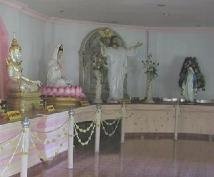 Most of the information for this article comes from Religious Tolerance.org. I have left out a few things not having to do with Mithras, and have added a few things I happen to know about the Mithraic Mysteries. My intent is always to show the similarity of religious traditions across time and culture.
Most of the information for this article comes from Religious Tolerance.org. I have left out a few things not having to do with Mithras, and have added a few things I happen to know about the Mithraic Mysteries. My intent is always to show the similarity of religious traditions across time and culture.
The early Christians and Pagans shared many rituals and practices. Authors Freke & Gandy appear to assume that all of the copying was done by Christians from Pagan sources. However, some might have gone in the opposite direction. During the 3rd century CE, Mithraism and Christianity were the main competitors for the religious affiliation the citizens of Romans. Some Christian practices might have actually been picked up by the Mithraites, rather than vice-versa.
The Bible records that Jesus was crucified between two thieves. One went to heaven and the other to hell. In the Mithras mysteries, a common image showed Mithras flanked by two torchbearers, one on either side. One held a torch pointed upwards, the other downwards. This symbolized ascent to heaven or descent to hell. [No so: In Mithraic temple wall carvings, the torch-bearers are often depicted beside the astronomical signs in which occur the equinoxes: the torch pointed upwards indicated the Vernal Equinox when the fiery sun gains strength; the downward-pointing torch heralded the Autumnal Equinox and the weakening sun. See: The Origins of the Mithraic Mysteries: Cosmology and Salvation in the Ancient World]
Christians and Mithraites celebrated the birthday of their god-man on DEC-25. [December 25 once was the date of the Winter Solstice, the day the Sun began to gain in strength, and therefore the day the Sun God was born.]
According to an ancient Christian tradition, Christ died on MAR-23 and resurrected on MAR-25. These dates agree precisely with the death and resurrection of Attis. [The Attis cult was closely connected to the Mithras cult according to Jesse L. Weston in Chapter 10 of From Ritual to Romance.]
[The reason for the March 25 resurrection was because that date once was the date of the Vernal Equinox and heralded spring, the season of "rebirth" or "resurrection."]
An inscription to Mithras reads: "He who will not eat of my body and drink of my blood, so that he will be made on with me and I with him, the same shall not know salvation." 1 In John 6:53-54, Jesus is said to have repeated this theme: "...Except ye eat the flesh of the Son of man, and drink his blood, ye have no life in you. Whoso eateth my flesh, and drinketh my blood, hath eternal life; and I will raise him up at the last day." (KJV)
Baptism was a principal ritual; it washed away a person's sins. In some rituals, Baptism was performed by sprinkling holy water on the believer; in others, the person was totally immersed.
Early Christians were naked when they were baptized. After immersion, they then put on white clothing and a crown. They carried a candle and walked in a procession to a basilica. Followers of Mithra were also baptized naked, put on white clothing and a crown, and walked in a procession to the temple. However, they carried torches.
Both the Catholic church and Mithraism had a total of seven sacraments.
Epiphany, JAN-6, was originally the festival in which the followers of Mithra celebrated the visit of the Magi to their newborn god-man. The Christian Church took it over in the 9th century. [See the article on Epiphany at Phoenix Qi explaining the astronomical significance of the date of the Epiphany.]




No comments:
Post a Comment